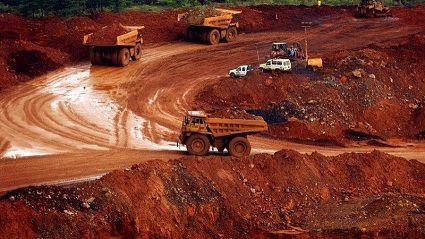By Our Correspondent
BHUBANESWAR/NEW DELHI: The Union Mines Ministry may go ahead with its move to remove provisions relating captive and non captive mines and is mulling to amend the MMDR Act.This will applicable for any future auction of mines. The sources said that as per the present system captive mines are catering exclusively to the captive plants. Accordingly mineral production was restricted in terms of quantity and grade of mineral required by the captive plant.
Now the stakeholders will offer their suggestions and taking into consideration, Ministry will bring in amendments to the MMDR Act.Mineral rich States such as Odisha, Chhattisgarh, Jharkhand will have a major say in bringing in amendments to the Central Act and advice of the State will be considered seriously.
A quick look to the India’s MMDR Act of 2015 and Mineral Laws (Amendment) Bill-2020 followed by high premium mining auction in Odisha and now the proposed reforms by the Ministry, has opened the Pandora box, which will either promote a more big mining scam in eastern Indian State of Odisha or as well as put several State Governments and Union Government for a longer legal battle.
The Ministry of Mines plan to delete the 10A (2b and 2c) Sections from the Mines and Minerals Development Regulation (MMDR) Act and also mulling over removal of the definition of captive and non-captive mines.Sources said that the provision of section 10(A)2 B and C was inserted in MMDR Amendment Act 2015 to safe guard the interest of ML/PL holders whose cases were pending with different State Government at that time .
These applications were filed long back as per the prevalent act as applicable in that time. Due to crawling process of government machineries these applications could not be converted in to mining leases in time bound manner. When some massive changes took place on January 12, 2015, the interest of these cases were well safeguarded by bringing the provisions of 10 A2B and 2 C. Though there was a time limit of 2 years in case of 10 A 2C but no time line was fixed in case of 10 A 2B, they said.
Different state govt kept pending all cases of 10 A 2 B for almost 5 years and no conclusive decision was taken over these cases. Now by just one stroke of pen all these cases will be scraped.In these last 5 years, government kept a blindfold over these cases, which is why the cases couldn’t be processed timely. If Central govt didn’t want to allot these cases on mere royalty basis then why government kept these cases in saving clause under 10 A2 B in MMDR Act 2015.Those applicants have put lot of money, time and efforts to keep their respective cases alive and waited for almost 5 years after enactment of amended act, they argued.
Now government want to allot all these blocks through auction process ,as the recent auction held in Odisha fetched very attractive premium and this has completely changed the mind set of state and central government. The second case pertaining to early termination of validity of captive mines by 5 years. The captive mining leases coming under 8A5 category were extended by almost 15 years ie upto 31.03.2030 mainly belonging to Tatas . Now early termination of the captive mines and scraping the provisions of right of first refusal creates lot of doubt at this stage, one of the Koira , Sundargarh based Mines owner said .
Recently Some mega steel companies mainly rivals of TISCO , like JSW Steel, Jindal Steel and Power Ltd and few more have grabbed several big size iron ore mines in Odisha though auction .Now they are thinking that in future they may not be able to compete with Tisco ,because they have taken mines @ more than 100% premium whereas TISCO will enjoy it’s mines for another 10 years on simple royalty basis.That’s why they may not be able to compete with Tisco in long run, they said.
For instance suppose if the IBM price of 1MT of iron ore is Rs 3,000 pmt, the auctioneers have to pay 3,000 plus royalty etc.If cost of production will be added with this premium and royalty it will be around 4,500 pmt(3,000 amount of premium at 100%,) Rs 700 royalty DMF etc 800 tentative cost of production.). For 1 mt of iron ore the auctioned miners have to pay around Rs 4,500. On contrary TISCO will have to bear only Rs 1,500 towards royalty and cost of production, they said.
For making 1 mt of steel almost 2 mt of iron ore is required. Simply Rs 6,000 per mt extra cost will be borned by these auctioned miners for steel making where as TISCO having vast advantages of its infrastructures like Raliway siding and mining leases of coal,lime stone,Dolomite etc and less cost of production , long period in hand having extra edge over their competitors. In event of depressed market sentiments where the profit in steel will be less than 6,000 pmt even after Tisco can make some profit but their competitors will have to suffer the losses. Therefore these extra facilities of Tata has became a point of envy for their rivals. By hook or crook they don’t want to see TISCO to enjoy furthermore, sources added.
Section 10A (2) (b) allowed an entity to acquire a mining lease for the mines allotted prior to auction regime without any sunset clause and 10A (2) (c) allowed an entity to get the environment and forest clearance within 2 years of the auction of mines.
There is a proposal is to define illegal mining under the MMDR Act. In the past, like in the case of Coal India, violation of environment/forest clearance has led to the state government of Odisha seek fine in the tune of Rs 20,000 crore in 2017 including around Rs 900 crore of Jindal Steel and Power Ltd and Sarda Mines Pvt Ltd over violation of Rule 37 and others acts. The amendment will clarify that mining within the mining lease area cannot be illegal under Section 21 (5) of the MMDR Act,
The Ministry had reportedly suggested bringing in early termination of captive leases from 2030 to 2025 and auction such mines without any first right of refusal. Another bold move that is being considered is that of transferring mines seamlessly whether it has been auctioned or allotted by the government. Under the current norms, only auctioned mines can be transferred and for non-captive mines, a transfer charge is levied equivalent to 80 percent royalty.
The resignation of TV Narendra, as President of Indian Steel Association, was an outcome of Tata Group’s concerns over captive and non-captive mines issues in the wake of media reports on mining and coal sectors facing reforms soon, sources said. TV Narendra is chief executive and managing director of Tata Steel. Earlier, several Gold mines owners in Karnataka had expressed their concerns on issues of 10A (2b and 2c) Sections from the Mines and Minerals Development Regulation (MMDR) Act as they feared huge loss since they invested crores in explorations in past 15 years and an open auction for the same gold bearing block, would put them in trouble.
Meanwhile, Odisha is amending Odisha Factory Act of 1948. Hemant Sharma, Principal Secretary Industries said the amendments being brought to the Industrial Policy Resolution (IPR) and Labor Laws is to boost the sector in Novel Corona Virus (COVID-19 Pandemic. Bringing in more investment and Generation of Employment is the prime move of the State Government in the COVID-19 Pandemic, he said.



























